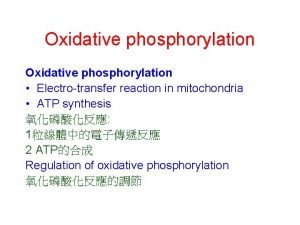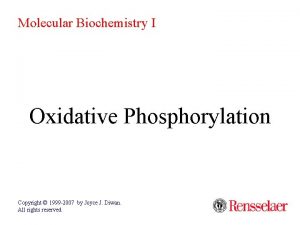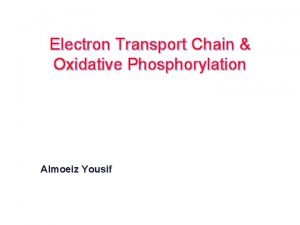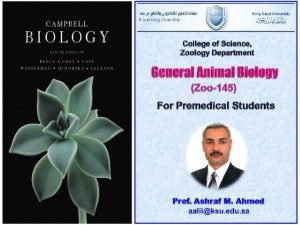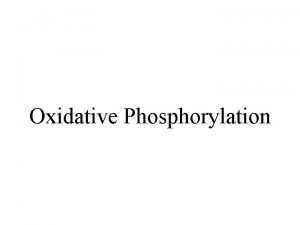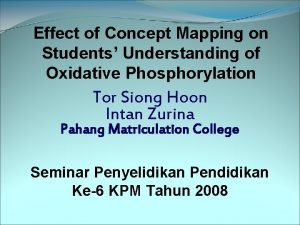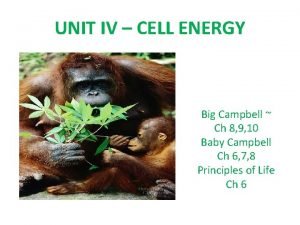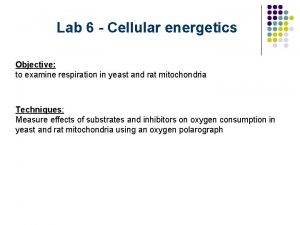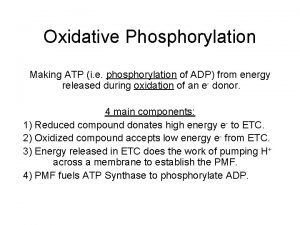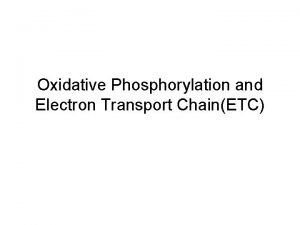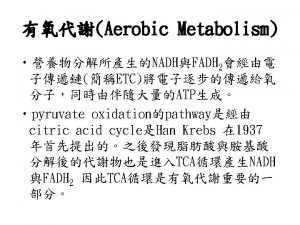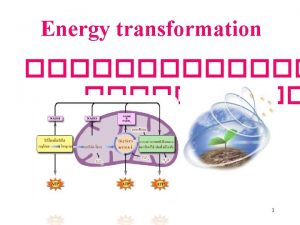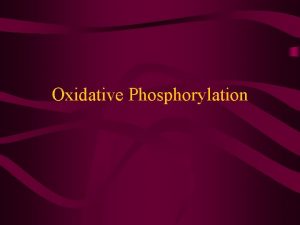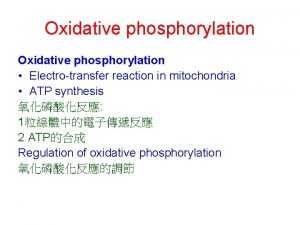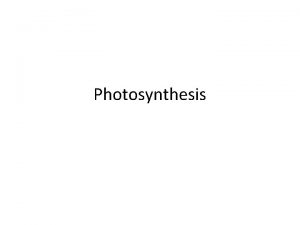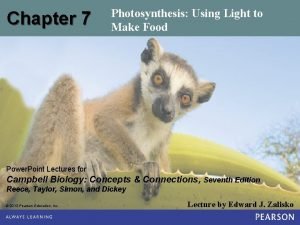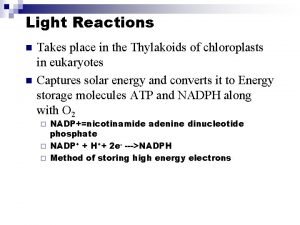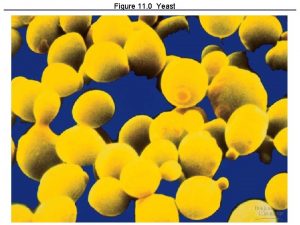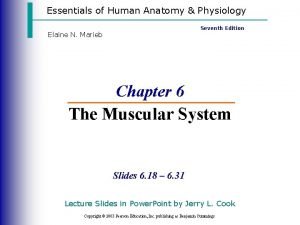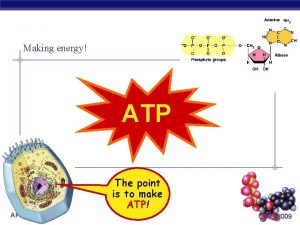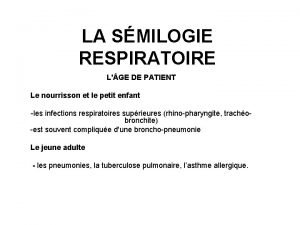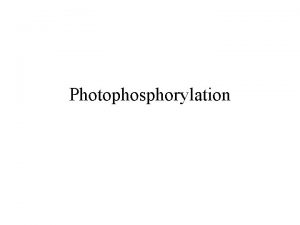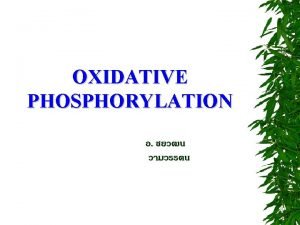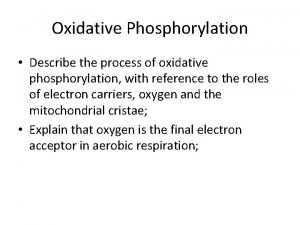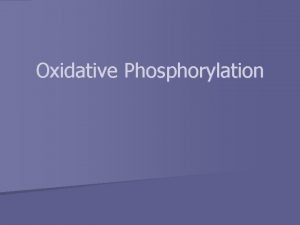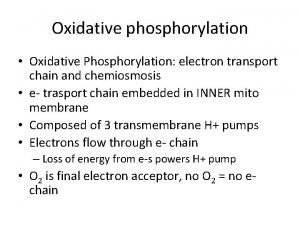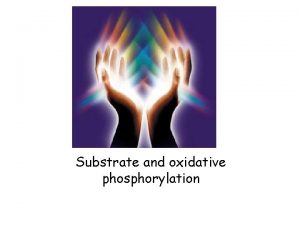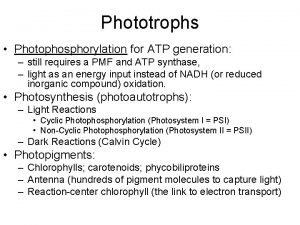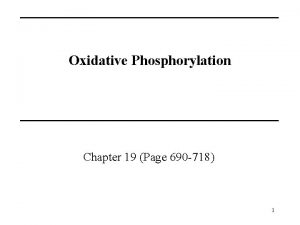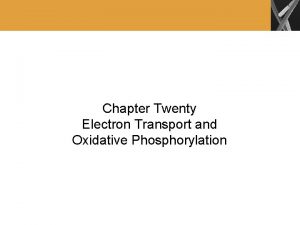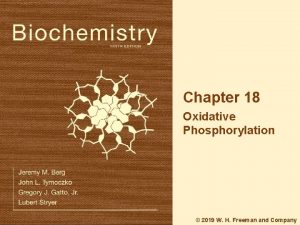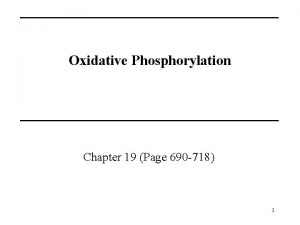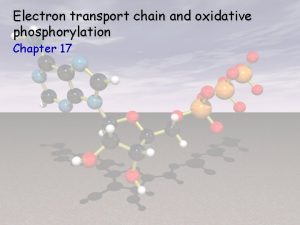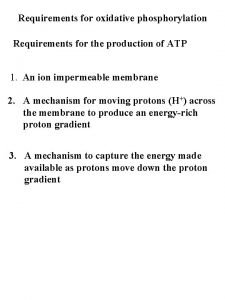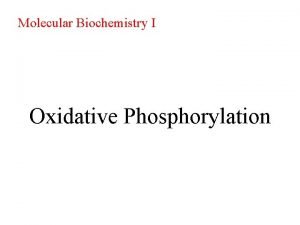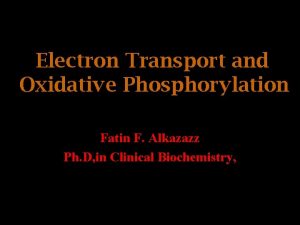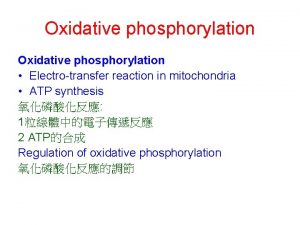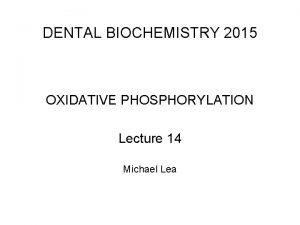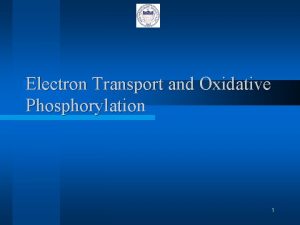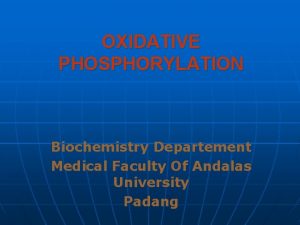Chapter 19 Oxidative Phosphorylation Photophosphorylation 1 Oxidative Phosphorylation


























- Slides: 26

Chapter 19 Oxidative Phosphorylation & Photophosphorylation 1

Oxidative Phosphorylation & Photophosphorylation Most of the ATPs are synthesized by Oxidative Phosphorylation or Photophosphorylation 2 Q 1. What is the ultimate goal for oxidative phosphorylation and photophosphorylation?

Oxidative Phosphorylation & Photophosphorylation Differences between Oxidative phosphorylation and Photophosphorylation In eukaryotes, oxidative phosphorylation occurs in mitochondria, photophosphorylation in chloroplasts. Oxidative phosphorylation involves the reduction of O 2 to H 2 O with electrons donated by NADH and FADH 2; it occurs equally well in light or darkness. Photophosphorylation involves the oxidation of H 2 O to O 2, with NADP+ as ultimate electron acceptor; it is absolutely dependent on the energy of light. Despite their differences, these two highly efficient energyconverting processes have fundamentally similar mechanisms. Q 1. What is the fundamental difference between oxidative 3 phosphorylation and photophosphorylation?

Oxidative Phosphorylation & Photophosphorylation Similarities between Oxidative phosphorylation and Photophosphorylation 4 Q 1. What is chemiosmotic theory? Q 2. Who proposed the chemiosmotic theory?

Oxidative Phosphorylation & Photophosphorylation Similarities between Oxidative phosphorylation and Photophosphorylation Oxidative phosphorylation and photophosphorylation are mechanistically similar in three respects. (1) Both processes involve the flow of electrons through a chain of membrane-bound carriers. (2) The free energy made available by this “downhill” (exergonic) electron flow is coupled to the “uphill” transport of protons across a proton-impermeable membrane, conserving the free energy of fuel oxidation as a transmembrane electro-chemical potential. (3) The transmembrane flow of protons down their concentration gradient through specific protein channels provides the free energy for synthesis of ATP, catalyzed by a membrane protein complex (ATP synthase) that couples proton flow to phosphorylation of ADP. Q 1. What are the mechanistic similarities between 5 oxidative phosphorylation and photophosrylation?

Oxidative Phosphorylation Permeability of Mitochondrial Outer and Inner Membranes Mitochondria, like gram-negative bacteria, have two membranes (Fig. 19– 1): The outer mitochondrial membrane is readily permeable to small molecules and ions. The inner mitochondrial membrane is not permeable to most small molecules and ions, including protons (H+): specific transporter proteins are required by small molecules and ions to cross this membrane. The inner membrane bears the components of the respiratory chain and the ATP synthase. Q 1. Diagrammatically explain the biochemical anatomy of a mitochondrion. Q 2. What is the difference between outerand inner mitochondial membrane with respect to transport of solutes? Q 3. Where do electron transport chain (ETC) components and the ATP 6 synthase reside?

Oxidative Phosphorylation ATP can be made by Substrate-level phosphorylation & Oxidative phosphorylation https: //www. slideshare. net/thelawofscience/cellular-respiration-oxidative-phosphorylation 7 Q 1. What are the two general methods by which ATP can be synthesized in biological systems?

Oxidative Phosphorylation ATP can be made by Substrate-level phosphorylation & Oxidative phosphorylation http: //slideplayer. com/slide/4905421/ Q 1. Schematically show ATP molecules are synthesized using 8 substrate-level and oxidative phosphorylation.

Oxidative Phosphorylation Scheme of the three key stages of production of ATP 9 Q 1. Schematically show electron transfer and oxidative phosphorylation are coupled.

Oxidative Phosphorylation Key stages of the production of ATP 1. Electron carriers are reduced during glycolysis and the citric acid cycle to NADH + H+ and FADH 2. These carriers then donate electrons and protons to the electron carrier proteins of the electron transport chain (ETC) in mitochondria. The final electron acceptor is oxygen. Together with oxygen, electrons and protons form molecules of water. 2. An electron transport chain (ETC) is a series of complexes that transfer electrons from electron donors to electron acceptors via redox (both reduction and oxidation occurring simultaneously) reactions, and couples this electron transfer with the transfer of protons (H+ ions) across a membrane. 3. The proton gradient produced by proton pumping during the electron transport chain is used to synthesize ATP. Protons flow down their concentration gradient into the matrix through the membrane protein ATP synthase, causing it to spin (like a water wheel) and catalyze conversion of ADP to ATP. 10 Q 1. Discuss the three key stages through which ATP is produced.

Oxidative Phosphorylation Components of mitochondrial ETC The protein components in mitochondrial ETC are: 1. Complex I (NADH dehydrogenase) 2. Complex II (Succinate dehydrogenase) 3. Complex III (Ubiquinone cytochrome c oxidoreductase) Cytochrome c (freely soluble protein between Complexes III and IV) 4. Cytochrome oxidase In the mitochondrial electron transport chain electrons move from an electron donor (NADH or FADH 2) to a terminal electron acceptor (O 2) via a series of redox reactions. These reactions are coupled to the creation of a proton gradient across the mitochondrial inner membrane. 11 Q 1. What are the protein components of ETC? Q 2. Discuss different protein components of ETC using a table.

Oxidative Phosphorylation Flow of electrons through ETC of mitochondrial inner membrane Q 1. Diagrammatically summarize the flow of electrons and 12 protons through the four complexes of the respiratory chain.

Oxidative Phosphorylation Chemiosmotic Model The flow of electrons through Complexes I, III, and IV results in pumping of protons across the inner mitochondrial membrane, making the matrix alkaline relative to the inter membrane space. This proton gradient provides the energy (in the form of the protonmotive force) for ATP synthesis from ADP and Pi by ATP synthase (Fo. F 1 complex) in the inner membrane. 13 Q 1. Discuss with a scheme the chemiosmotic model of Peter Mitchell.

Oxidative Phosphorylation Fo. F 1 ATP synthase Fo. F 1 synthase catalyzes the conversion of ADP and inorganic phosphate to ATP. Fo domain transfers 4 protons and F 1 domain converts ADP and Pi to ATP. Matrix Intermembrane space http: //fig. cox. miami. edu/~cmallery/150/makeatp. htm Q 1. Name an enzyme that carries out “rotational catalysis”. Q 2. What are the phosphate : oxygen ratio when electrons enter at Complex I and coenzyme Q (ubiquinone) of 14 the electron transport chain?

Oxidative Phosphorylation Shuttle systems indirectly convey cytosolic NADH into mitochondria for oxidation Q 1. What are the shuttle systems that carry NADH from the cytosol to mitochondria? Q 2. What is the malate-aspartate shuttle? In which tissues this shuttle system operates? Q 3. What is glycerol 3 -phosphate shuttle? In which tissues this shuttle system operates? Q 4. How many ATP molecules are produced upon transfer of a pair of electrons to oxygen through ETC using (a) malate-aspartate shuttle, (b) glycerol 3 - 15 phosphate shuttle?

Oxidative Phosphorylation ATP yield from complete oxidation of one molecule of Glucose 16 Q 1. Using a table show the ATP yield from complete oxidation of one molecule of glucose.

Oxidative Phosphorylation Biologic significance of fuel oxidation to produce heat (not ATP) http: //www. fitnessvsweightloss. com/winter-is-the-best-time-for-losing-weight/ Q 1. What is brown fat? Why is it called so? Q 2. What is the name of the unique protein in brown fat? No question on the images of this slide in exam. 17 http: //www. elsevier. es/es-revista-endocrinologia-nutricion-english-edition--412 -articulo-adipose -tissue-cell-heterogeneity-functional-S 2173509314000336

Oxidative Phosphorylation Biologic significance of fuel oxidation to produce heat (not ATP) Q 1. Diagrammatically explain how heat is generated by thermogenin or uncoupling protein in mitochondria? 18 Q 2. Give two biologic significance of the heat produced by brown fat.

Photophosphorylation Chloroplasts Q 1. Where does photosynthesis take place in plants? Q 2. Diagrammatically show different parts of chloroplasts. 19 Q 3. What are thylakoids, granna, lamellae, stroma?

Photophosphorylation Chloroplasts http: //slideplayer. com/slide/7742400/ 20 No question in exam from the image of this slide.

Photophosphorylation Light drives electron flow in chloroplasts Q 1. What is Hill reaction with respect to photosynthesis? Q 2. What is the biological electron acceptor in the chloroplasts? 21 No question in exam on Dichlorophenolindophenol.

Photophosphorylation Light absorbing pigments in plants The most important light-absorbing pigments in the thylakoid membranes are the chlorophylls, green pigments with polycyclic, planar structures resembling the protoporphyrin of hemoglobin, except that Mg 2+, not Fe 2+, occupies the central position. In addition to chlorophylls, thylakoid membranes contain secondary light-absorbing pigments, or accessory pigments, called carotenoids. Carotenoids may be yellow, red, or purple. The most important are β-carotene, which is a redorange isoprenoid, and the yellow carotenoid lutein (Fig. 19– 40 c, d). The carotenoid pigments absorb light at wavelengths not absorbed by the chlorophylls (Fig. 19– 41) and thus are supplementary light receptors. Q 1. Name the most-important light-absorbing pigments in plants. 22 Q 2. Name two secondary light-absorbing pigments in plants. No question in the exam on the structures of chlorophyll and lutein.

Photophosphorylation Photosystems The light-absorbing pigments of thylakoid or bacterial membranes are arranged in functional arrays called photosystems. In spinach chloroplasts, for example, each photosystem contains about 200 chlorophyll and 50 carotenoid molecules. All the pigment molecules in a photosystem can absorb photons, but only a few chlorophyll molecules associated with the photochemical reaction center are specialized to transduce light into chemical energy. The other pigment molecules in a photosystem are called light-harvesting or antenna molecules. They absorb light energy and transmit it rapidly and efficiently to the reaction center (Fig. 19– 45). Q 1. What are photosystems? Q 2. What is photochemical reaction center? 23 energy? Q 3. Which type of chlorophylls can transduce light into chemical Q 4. What are antenna chlorophylls? What is their importance?

Photophosphorylation ATP synthesis in thylakoids 24 No question in the exam from this slide.

Photophosphorylation ATP synthesis by photophosphorylation & Utilization of it in making Carbohydrates https: //sites. google. com/a/fhsbiology. com/main/faculty/mrderosa/lab-biology-1/marking-period-4/photosythesis Q 1. Diagrammatically show light-induced formation of ATP can be used for the synthesis of 25 carbohydrates by Calvin cycle in chloroplast.

Next Lecture: Overview of Metabolic Pathways-VI Reference Textbook: Lehninger Principles of Biochemistry 4 th or 5 th Edition Chapters 14 -23 David L. Nelson, Michael M. Cox WH Freeman & Company, New York, USA 26
 Uncouple oxidative phosphorylation
Uncouple oxidative phosphorylation Uncouplers of oxidative phosphorylation
Uncouplers of oxidative phosphorylation Oxidative phosphorylation
Oxidative phosphorylation Substrate level phosphorylation vs oxidative
Substrate level phosphorylation vs oxidative Uncouplers of oxidative phosphorylation
Uncouplers of oxidative phosphorylation Concept map about oxidative phosphorylation.
Concept map about oxidative phosphorylation. Oxidative phosphorylation enzymes
Oxidative phosphorylation enzymes Oxidative phosphorylation energy yield
Oxidative phosphorylation energy yield Oxidative phosphorylation
Oxidative phosphorylation Energetics of oxidative phosphorylation
Energetics of oxidative phosphorylation Inhibitors of oxidative phosphorylation
Inhibitors of oxidative phosphorylation Inhibitors of oxidative phosphorylation
Inhibitors of oxidative phosphorylation Uncouplers of oxidative phosphorylation
Uncouplers of oxidative phosphorylation Oxidative phosphorylation
Oxidative phosphorylation Define oxidative phosphorylation
Define oxidative phosphorylation Atp synthesis
Atp synthesis Non cyclic photophosphorylation
Non cyclic photophosphorylation Light energy
Light energy Photophosphorylation
Photophosphorylation Photsystems
Photsystems Direct phosphorylation
Direct phosphorylation Phosphorylation cascade
Phosphorylation cascade Incomplete tetanus muscle contraction
Incomplete tetanus muscle contraction Phosphorylation cascade
Phosphorylation cascade Enzymes in substrate level phosphorylation
Enzymes in substrate level phosphorylation Substrate level phosphorylation
Substrate level phosphorylation Sémilogie
Sémilogie
